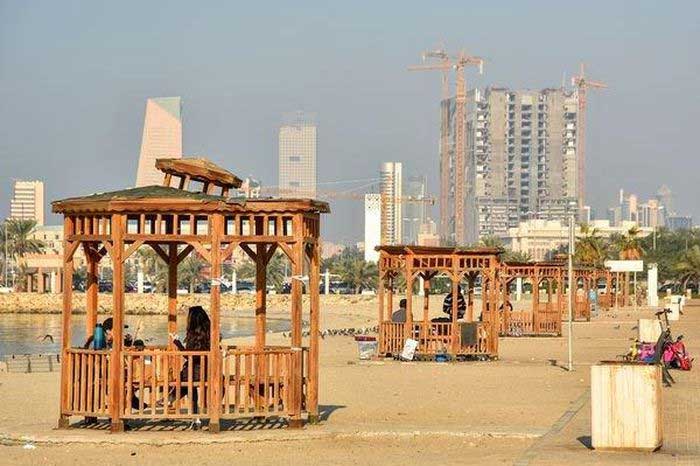Global warming is gradually breaking temperature records around the world, but for Kuwait, one of the hottest countries on the planet, this situation is spiraling out of control.
Temperature Rise Beyond Control
In 2016, temperatures in the country reached 54 degrees Celsius, the highest on Earth in the past 76 years.
In 2021, for the first time, the temperature hit the 50 degrees Celsius mark in June, just before entering the peak annual heat wave.
According to calculations by the U.S. Environmental Protection Agency (EPA), from 2071 to 2100, some areas of Kuwait could see a rise of 4.5 degrees Celsius compared to historical averages, making those areas nearly uninhabitable.
 Pigeons seeking shade under a tree in Kuwait City. (Photo: AFP).
Pigeons seeking shade under a tree in Kuwait City. (Photo: AFP).
Wildlife is facing similar challenges. It is difficult to find shade or drinking water for birds, with numerous dead birds found on rooftops during the brutal summer months.
Veterinary clinics are overwhelmed as many stray cats are brought in suffering from heat exhaustion and dehydration. Even wild foxes are forced to flee to other areas.
Tamara Qabazard, a veterinarian at the Kuwait Zoo, stated: “The reason we are seeing fewer wild animals in Kuwait is that they cannot survive the extreme weather conditions here. Many animals are experiencing respiratory issues.”
Targets Too Low
Unlike Bangladesh or Brazil, which are struggling to balance environmental issues, livelihoods, and poverty, Kuwait lacks financial resource constraints and is the fourth-largest oil exporter of the Organization of the Petroleum Exporting Countries (OPEC).
Kuwait has the third-largest sovereign wealth fund in the world and has a population of just over 4.5 million. The country has ample resources to cut greenhouse gas emissions and adapt to climate change; the issue lies in the lack of appropriate political action.

People seeking shade in a gazebo on Shuwaikh beach in Kuwait City. (Photo: Bloomberg).
Even Kuwait’s neighboring countries, which also depend on crude oil exports, have committed to taking action to adapt to climate change.
In 2021, Saudi Arabia announced a net-zero target by 2060, while the United Arab Emirates (UAE) set its target for 2050.
Both countries have declared research efforts to diversify their economies, investing in renewable and clean energy. The next two United Nations climate conferences will be held in Egypt and the UAE, as governments in the Middle East acknowledge that they too are suffering significant damage from rising temperatures and sea levels.
In contrast, Kuwait only committed at the COP26 Summit to reduce greenhouse gas emissions by 7.4% by 2035. This is a significantly lower target compared to the 45% reduction needed to meet the long-term goal of the Paris Agreement on climate change to limit warming to 1.5 degrees Celsius by 2030.
Manal Shehabi, a scholar at the University of Oxford specializing in Gulf countries, noted: “Compared to the rest of the Middle East, Kuwait is lagging in climate adaptation. In a region heavily impacted by global warming, Kuwait’s climate commitments are far too low.”
Sheikh Abdullah Al-Ahmed Al-Sabah, head of the EPA, stated at the COP26 conference that Kuwait is interested in supporting international initiatives aimed at stabilizing the climate. Kuwait also committed to implementing a “national carbon reduction strategy,” but did not specify plans and has little documentation regarding this commitment.
Lack of Concern
Jassim Al-Awadhi, 32, representing the younger generation of Kuwait, is deeply concerned about the future of his country.
He quit his job at a bank to advocate for a change that experts believe could be key to finding new solutions: improving transportation issues.
His goal is to encourage Kuwaitis to use public transportation more, which currently consists only of buses, typically used by low-income migrant workers.

Jassim Al-Awadhi in a bus shelter on January 9. (Photo: Bloomberg).
It is a difficult struggle. Although Kuwait has the highest per capita carbon dioxide emissions in the world, their proposal to completely ban cars is virtually impossible in a country where gasoline is cheaper than Coca-Cola and cities favor cars.
The London School of Economics, which conducted the only climate survey in Kuwait, found that older individuals are less concerned, with some believing it is a conspiracy to undermine the Gulf economies.
In a community survey, all respondents over 50 opposed plans to build a subway network similar to that in Riyadh and Dubai. The private sector also views climate change response as the government’s responsibility.
Most Kuwaitis and the wealthy are insulated from the impacts of high temperatures. Homes, shopping centers, and cars are all equipped with air conditioning, and those with means often spend summers in Europe.
However, reliance on cooling systems also increases fossil fuel consumption, leading to even hotter temperatures. This is even worse for low-income workers. Although the government prohibits outdoor work during peak afternoon hours in the scorching summer months, they still have to work under the sun to make a living.
According to a study published in the journal Science Direct, during peak heat days, the number of deaths doubles, but this figure triples for non-Kuwaiti male laborers.
Political Bottleneck
Despite the increasing risks, the power struggle between the solely elected parliament and the government appointed by the King has made it difficult to push for climate reforms and other initiatives.
Samia Alduaij, an environmental consultant in Kuwait, stated: “The political deadlock in Kuwait is just sucking all the oxygen out of the air. This is a very wealthy country with a very small population, so they could do much better.”
So far, the plan to generate 15% of Kuwait’s electricity from renewable sources by 2030, up from a maximum of 1%, has yielded very little results.
Kuwait’s oil resources are so abundant that they can be burned to generate electricity, fueling 2 million cars, which further contributes to air pollution.
Some power plants have switched to using gas, but this can easily leak methane— a potent greenhouse gas. The heavily subsidized consumption of electricity and water has proven politically toxic, even risking cuts to those very benefits.

Severe traffic congestion on Abdul Aziz bin Abdul Rahman Al Saud Street, Kuwait City, on January 8. (Photo: Bloomberg).
Nadim Farajalla, director of the climate change and environment program at the University of Beirut, stated that if action is taken now, there is much to be done, including: combating rising sea levels, making cities greener, and creating energy-efficient buildings. Kuwait also needs to focus on addressing transportation issues, a leading cause of CO2 emissions.
Khaled Mahdi, secretary-general of the Kuwait Supreme Council for Planning and Development, stated that the government’s adaptation plans align with international policies.
The Kuwait Commute advocacy group led by Al-Awadhi is working on initiatives such as building bus shelters to help passengers avoid the sun.
The National Bank of Kuwait, the country’s largest lending bank, has funded the student-designed bus stop project. However, like much of the private sector, they remain outside the decision-making process.
Al-Awadhi hopes that increased bus ridership among Kuwaitis will create a strong demand for improving public services.


















































